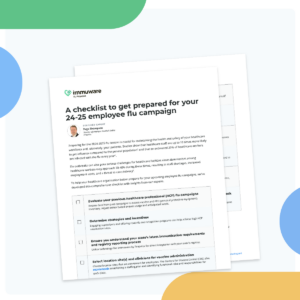Featuring Page Thompson, Director of Employee Health & Safety at Propelus
Flu season presents a unique opportunity for healthcare facilities to enhance their preparedness and safeguard both staff and patients. By taking proactive steps—such as promoting vaccination, reinforcing hygiene practices, and developing contingency plans for potential staffing shortages—healthcare employers can help protect their teams while continuing to provide the highest quality care. With thoughtful planning and a focus on prevention, you’ll be well-equipped to meet the challenges flu season brings and maintain a safe, healthy environment for everyone.
In this blog, we share actionable strategies for flu prevention and management. These strategies will help keep your hospital or clinic healthy over the upcoming months and maintain a safe environment for both patients and staff.
Promoting Flu Vaccination Among Healthcare Workers
Flu vaccinations play a key role in protecting both healthcare workers and patients. Annual vaccines help shield you from current flu strain and can lessen the severity of symptoms if someone does contract it. To help boost vaccination rates, consider implementing strategies that make it easy and convenient for staff. Offering onsite vaccination clinics, for example, ensures employees can get vaccinated even during long shifts. Educational campaigns that provide information on the flu, the current vaccination, and up-to-date statistics can be implemented through team meetings and notice boards throughout the workplace.
Implementing Effective Infection Control Measures
As flu season approaches, it’s important to review and strengthen your infection control measures to help keep both staff and patients safe. Reinforcing simple but essential practices – like regular handwashing and proper use of PPE – can go a long way in reducing flu transmission and spread of germs. Having Isolation procedures in place for any flu cases will help prevent the spread of illness and ensure patient and employee safety. Regular staff training is key to keeping everyone up to date on these practices, empowering your team to take the right actions to protect themselves and those in their care.
Ensuring Adequate Staffing and Contingency Planning
While the strategies above can help reduce flu cases in your hospital or clinic, it’s still important to be prepared for potential flu-related staff shortages. Before flu season begins, have a planning session with your leadership team to prepare for potential staff shortages. Develop contingency plans for critical roles and departments, identifying areas of the workplace that would be most impacted should you have a flu outbreak. Cross-training your staff ahead of time can ensure they’re ready and confident to step into different roles if needed, while flexible work arrangements can provide extra support to maintain full coverage throughout your facility. If you use volunteer vaccinators or temporary staff, it is even more important that your vaccination administration process is simple and easy to use, ensuring that these workers can contribute effectively. With thoughtful planning, you can be ready to meet flu season with confidence.
Enhancing Patient Education and Communication
Flu season is a great time to educate patients about flu prevention, symptoms, and when to seek care. Many may underestimate the flu, but clear guidance can help reduce its spread in healthcare settings. Establish clear communication channels for flu-related updates and guidelines to help you share relevant and current information about the flu season. Providing flu-related resources in multiple languages makes vital information accessible to all, while focusing on conversations with high-risk patients provides them with the extra support they need. With effective communication, you can help patients stay informed and prepared throughout flu season.
Creating a Healthy Environment for Patients and Visitors
It’s important for patients and visitors to feel safe and protected when visiting your healthcare facility during the flu season. Keeping the environment clean and sanitized helps reduce the spread of flu, while providing hand sanitizers and masks at areas offers added protection. If you notice a quick upturn in the number of flu cases, consider managing visitor access and implementing screening measures to help minimize risk. By fostering a healthy environment, you can help everyone feel more secure during this time of year.
Leveraging Technology for Flu Season Preparedness
Modern technology offers valuable support for hospitals and healthcare facilities during flu season. Tools like electronic health record (EHRs) and platforms like Immuware make it easier to track flu vaccination status among staff and volunteers – and make managing vaccination campaigns easier. Implementing telehealth services can also help reduce in-person visits during peak flu season, minimizing the risk of flu transmission between employees and patients.
Page Thompson, Director of Employee Health & Safety at Propelus, notes, “The value of an electronic solution for managing the administration of your annual flu season goes well beyond the centralization of information into a single, reliable source of truth. It provides a seamless way to track vaccinations, ensuring accuracy and up-to-date records across your organization.”
Monitoring and Adapting to Flu Season Trends in North America
Each flu season presents different challenges, with varying strains and symptoms. Keeping up with local and national flu activity reports helps you stay informed about rising cases in your area. If flu activity increases, quickly implementing visitor access controls and screening measures can help protect both your staff and patients.
Preparation is vital to navigating flu season effectively. By taking proactive steps before flu season begins, you can better prevent its spread within your facility. The good news is that technology such as Immuware makes it easier to ensure your team is up to date with their vaccinations and keep track of data that can help make this flu season more manageable. Thompson states, “Many organizations must temporarily expand their workforce with volunteer vaccinators or temporary staff to meet the increased demand for employee vaccinations during flu season. By utilizing an electronic system that is easy to use and provides a simple automated, streamlined process for all clinicians, our clients have seen dramatic time savings in the vaccination administration process that has allowed them to achieve their compliance goals while minimizing overtime and the 14 hours days of the past.”
Start planning now with Immuware to stay ahead of the flu.
_______________________________________________________________________________________________
Learn how to optimize your employee flu campaign. Our flu preparedness interactive checklist offers:
- Actionable steps: optimize your flu campaign on past data.
- Proven strategies: increase employee vaccination rates.
- Latest requirements: understand how to meet your state’s immunization requirements.
- Practical tips: select convenient vaccination locations and qualified clinicians.
- Comprehensive preparation: ensure all forms and questionnaires are up-to-date.
Get your flu checklist here.

